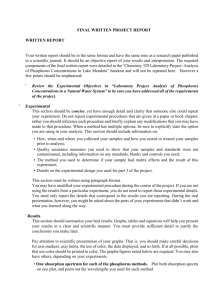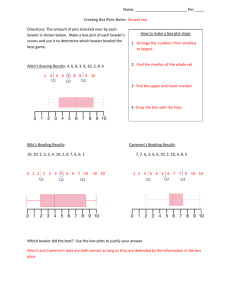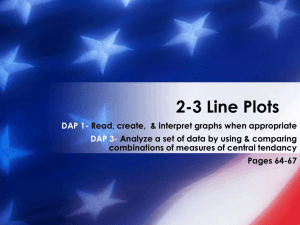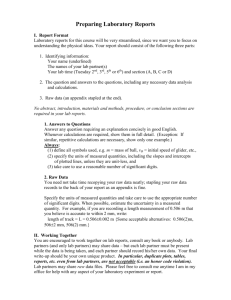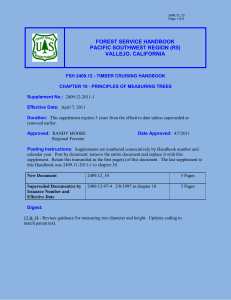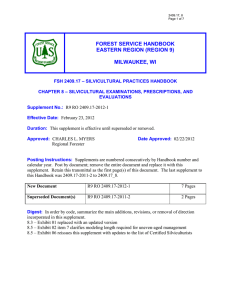r2-2409-30-2014
advertisement
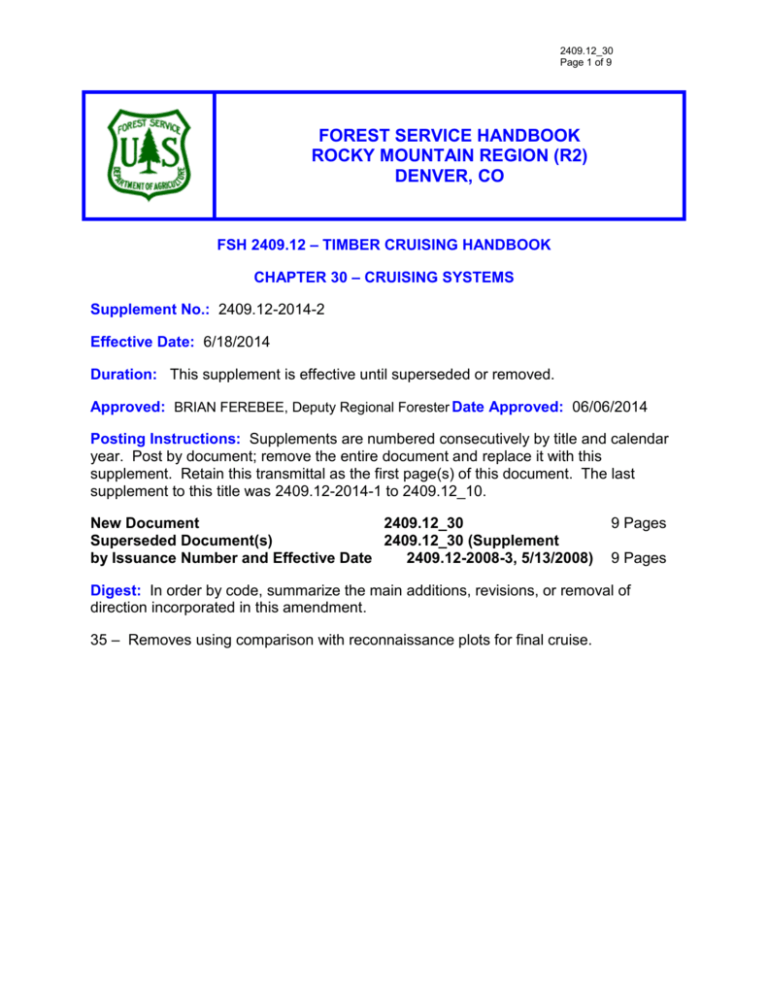
2409.12_30 Page 1 of 9 FOREST SERVICE HANDBOOK ROCKY MOUNTAIN REGION (R2) DENVER, CO FSH 2409.12 – TIMBER CRUISING HANDBOOK CHAPTER 30 – CRUISING SYSTEMS Supplement No.: 2409.12-2014-2 Effective Date: 6/18/2014 Duration: This supplement is effective until superseded or removed. Approved: BRIAN FEREBEE, Deputy Regional Forester Date Approved: 06/06/2014 Posting Instructions: Supplements are numbered consecutively by title and calendar year. Post by document; remove the entire document and replace it with this supplement. Retain this transmittal as the first page(s) of this document. The last supplement to this title was 2409.12-2014-1 to 2409.12_10. New Document 2409.12_30 Superseded Document(s) 2409.12_30 (Supplement by Issuance Number and Effective Date 2409.12-2008-3, 5/13/2008) 9 Pages 9 Pages Digest: In order by code, summarize the main additions, revisions, or removal of direction incorporated in this amendment. 35 – Removes using comparison with reconnaissance plots for final cruise. Region 2 Supplement: 2409.12-2014-2 EFFECTIVE DATE: 06/18/2014 DURATION: This supplement expires 5 years from the effective date unless superseded or removed earlier. 2409.12_30 Page 2 of 9 FSH 2409.12 – TIMBER CRUISING HANDBOOK CHAPTER 30 – CRUISING SYSTEMS 33 – SAMPLE-TREE WITH COMPLETE TALLY 33.11 – Operational Features Mark sample trees in the following manner to help with sample location and identification during presale inspection or check-cruises: 1. Paint a continuous band around the tree at about eye level. 2. Paint the sample number legibly. 3. Paint the cruiser ID legibly. 4. Identify with flagging. Sample tree cruising often includes breaking individual species into sampling strata based on DBH-groups. Expect that some trees measured as samples may have a DBH just slightly different from the estimate made when the tree was tallied, and just outside the strata limit. When this happens use the following procedure to maintain the random and unbiased nature of the sample process: In all cases, keep a sample tree in the strata it was originally called in. Do not skip the tree or make other adjustments when it's taped DBH is outside the strata limits. These trees represent other tallied trees that may have been called outside their "true" DBH-group. Their effect will be to increase strata CV, usually by a very slight amount. If a follow-up crew will be measuring the samples, be sure to mark the sample trees in a way that indicates their "called" strata. 34.21 – Sample Plot Location and Monumentation of Plots and Trees Identify plot centers with a firmly implanted solid stake. Do not use a wire pin. Indicate the plot center by marking the top of the stake with an indelible "X" or a nail. Use a grid system based on a random start to locate plot centers on the cruise map. Use the Mirage method as described below and in exhibit 01 when fixed plots land so their boundary would overlap outside the sale area or into a different cruise stratum. As shown, measure the distance to the boundary, B, and establish a correction plot center by going this distance beyond the boundary. Tally each tree in the shaded portion of exhibit 01 twice in the sample. Region 2 Supplement: 2409.12-2014-2 EFFECTIVE DATE: 06/18/2014 DURATION: This supplement expires 5 years from the effective date unless superseded or removed earlier. 2409.12_30 Page 3 of 9 FSH 2409.12 – TIMBER CRUISING HANDBOOK CHAPTER 30 – CRUISING SYSTEMS 34.21 - Exhibit 01 Mirage Method When Used In Conjunction With Fixed Area Plots If point sampling is used, although plot size varies with tree diameter, overlap is easily detected; it exists when the radius of the plot associated with the tree exceeds the distance B, from the sample point to the boundary. In point sampling field application, making use of the mirage method, one need not actually determine whether overlap exists; it is only necessary to proceed the distance B out from the boundary, sight back toward the forested area with the angle gauge (prism, relascope, and so forth) and tally all qualifying trees from the correction point. Of course, if overlap is present, certain trees will be the same ones tallied from the original sample point. If there is no overlap, no trees will qualify from the correction point. Do not tally a tree from a correction point unless it has first been tallied from the sample point. Only trees inside the unit are tallied from the correction point. Exhibit 02 illustrates the use of the mirage method. If the plot boundary overlaps both sides, and also completely overlaps the corner itself, a total of three correction plots are needed. If the plot boundary overlaps both sides, but not the corner, establish two correction plot centers D and D2. From each correction plot center tally those trees Region 2 Supplement: 2409.12-2014-2 EFFECTIVE DATE: 06/18/2014 DURATION: This supplement expires 5 years from the effective date unless superseded or removed earlier. 2409.12_30 Page 4 of 9 FSH 2409.12 – TIMBER CRUISING HANDBOOK CHAPTER 30 – CRUISING SYSTEMS falling inside the cruise area boundary. Two sets of trees will be tallied twice. Note: When three correction plots are established (four total plots), some trees will be tallied only once, some twice, some three times, and some four times. 34.21 - Exhibit 02 Mirage Method 34.22 – Establishing Plot Boundaries Use the slope corrections factors shown in section 91, exhibit 02, regional supplement. 35 – POINT SAMPLING The 3PPNT is an approved cruise method that works well in sales with low value forest products, where all that is needed is a reliable estimate of the volume. The cruise method is a two-stage sampling system, (1) select sample trees in proportion to tree basal area in the sample point first stage, and (2) make a 3P estimate of the point in the second stage. In order to know how many plots are needed, a recon cruise should be done to determine the CV of the timber. When that is known, it can be determined how many total plots are needed and how many of those total plots need to be measured. A KZ value can be arrived at to get the correct ratio of total plots and measure plots. Grid the total number of plots on a photo or map of the cutting units. Establish the plot center and determine how many trees are in the variable plot factor. An estimate is made of the average tree height to arrive at an estimated volume per acre on that plot. When Region 2 Supplement: 2409.12-2014-2 EFFECTIVE DATE: 06/18/2014 DURATION: This supplement expires 5 years from the effective date unless superseded or removed earlier. 2409.12_30 Page 5 of 9 FSH 2409.12 – TIMBER CRUISING HANDBOOK CHAPTER 30 – CRUISING SYSTEMS the predicted volume per acre equals or exceeds the random number, it becomes a measure plot. The process to arrive at estimated plot volume is: Pcf = BAF x #T x H 3 Where, Pcf = cubic foot volume per acre prediction for ith plot #T = number of trees H 1 / 3 Total Height Average 3 Instructions for Matrix: The only part that will be in the matrix before determining the number of plots for both stages will be the range of 3P errors. Plot Error # Of Plots 3P Error # Of Measured Plots 10 12 14 16 Plot error is determined by taking square root of the desired error squared minus the 3P error. Plot error = = = 302 102 800 28.3 The number of plots is calculated by multiplying the t factor of 2 times the CV (obtained from the recon cruise) divided by the plot error and squaring it. A CV of 100 is used in the following sample calculation. Region 2 Supplement: 2409.12-2014-2 EFFECTIVE DATE: 06/18/2014 DURATION: This supplement expires 5 years from the effective date unless superseded or removed earlier. 2409.12_30 Page 6 of 9 FSH 2409.12 – TIMBER CRUISING HANDBOOK CHAPTER 30 – CRUISING SYSTEMS n t 2CV 2 (tCV ) 2 (2 x100) 2 40,000 49.94 50 E2 E2 28.32 800.89 The number of measure plots is done the same way except the 3P error and cruiser CV are used. n t 2CV 2 (tCV ) 2 (2 x30) 2 3600 36 E2 E2 10 2 100 Solve for all the combinations and finish filling in the matrix. Plot Error # Of Plots 3P Error # Of Measured Plots 28.3 50 10 36 27.5 53 12 25 26.5 57 14 18 25.3 62 16 14 Select the one that will take the least amount of time. BAF = Basal Area Factor T = Number of trees counted on ith plot H = Estimated average height of counted trees on ith plot The variable of interest at the first stage is volume per acre while the variable of interest in the second stage is the measured to predicted ratio. The predictions are made in cubic feet. The easiest way to do a 3PPNT cruise is to use a field data recorder. FSCruiser will calculate the volume per acre prediction just by entering the number of trees and an average height. A matrix is used to arrive at a combination of total plots and measure plots. After analyzing the combinations, choose the most efficient one. Given: Volume per acre CV = 100% 3P cruiser CV = 30% Desired error = 30% Plot Error # Of Plots 28.3 50 27.5 53 26.5 57 25.3 62 Region 2 Supplement: 2409.12-2014-2 EFFECTIVE DATE: 06/18/2014 DURATION: This supplement expires 5 years from the effective date unless superseded or removed earlier. 2409.12_30 Page 7 of 9 FSH 2409.12 – TIMBER CRUISING HANDBOOK CHAPTER 30 – CRUISING SYSTEMS 3P Error # Of Measured Plots 10 36 12 25 14 18 16 14 The total desired error must be divided up between the plot error and 3P error. A good place to start is approximately 1/3 of total error allocated to the 3P portion. Once the number of plots is known, the KZ must be calculated. Given: The option with 57 total plots and 18 measure plots was selected. The recon cruise showed there was an average of 6 trees per plot using a 5 BAF. 6 trees per plot x 5 BAF = 30 square feet basal area 1/3 total height = 12 feet 30 square feet x 12 feet ht. = 360 cubic feet per acre average The sum of the KPIs for the sale = 360 x 57 plots = 20,520 cubic feet 20,500 1138 ( KZ value) 18 By the time the cruise is done, the computer program will select a measure plot approximately every 1138 cubic feet. 35.21 – Sample Point Location and Monumentation of Points and Trees Establish map locations and monument point centers in the same fashion as described for plot centers in section 34.21. Use the Mirage method as described in section 34.21. 35.22a - Assessing Borderline and Other Questionable Trees The parent text prescribes measuring limiting distance to the face of the tree. Data recorder routines for limiting distance are based on this measurement, not on the distance to the tree center. Section 91, exhibit 02 (regional supplement) provides tables of factors to use in hand calculations for limiting distance. 37.24 - Calculating Sample Size The following section provides a guide for determining the number of samples needed for the Fixed-Area Plot with 3P Subsample Cruising Method. The process involves two basic steps: Region 2 Supplement: 2409.12-2014-2 EFFECTIVE DATE: 06/18/2014 DURATION: This supplement expires 5 years from the effective date unless superseded or removed earlier. 2409.12_30 Page 8 of 9 FSH 2409.12 – TIMBER CRUISING HANDBOOK CHAPTER 30 – CRUISING SYSTEMS 1. Based on precruise data, build an array showing a practical range of combinations for fixed-plots versus 3P sample trees. 2. Select the most efficient combination based on cruising costs and other factors. The following example illustrates the specific steps and calculations. 1. Given: a. Presale measurement sale, conifer 3.5 MMBF (7000 Ccf), targeted sampling error of 20 percent. b. Estimated 3P CV is 25 percent. c. Estimated 3P sampling error of 8 percent. d. Estimated plot CV is 65 percent. e. t = 2 for 95% probability. 2. Determine the desired sampling error for the sale as a whole. 3. Estimate the error for one of the sampling methods. 3P error is generally the more easily estimated of the two errors. Use data from past cruises to estimate the 3P error and CV. Display the error in the first row of an array, along with several increments above and below the estimated error. STEP-2 3P ERROR 7.0 7.5 8.0 8.5 9.0 STEP-3 NUMBER OF 3P SAMPLE TREES 51 44 39 35 31 STEP-4 PLOT ERROR 18.7 18.5 18.3 18.1 17.9 STEP-5 NUMBER OF PLOTS 48 49 50 52 53 4. Calculate the number of 3P samples needed to meet the estimated 3P error, and then repeat this step for the other increments of 3P error. Display the number of samples below the corresponding error. 3P Sample Trees n (t ) 2 (CV ) 2 (2) 2 (25) 2 39 E2 8.0 2 Region 2 Supplement: 2409.12-2014-2 EFFECTIVE DATE: 06/18/2014 DURATION: This supplement expires 5 years from the effective date unless superseded or removed earlier. 2409.12_30 Page 9 of 9 FSH 2409.12 – TIMBER CRUISING HANDBOOK CHAPTER 30 – CRUISING SYSTEMS 5. Use the sale sampling error and estimated 3P error to calculate the fixed plot error. Sample calculations for the mid-point 3P error are shown below: Plot Error ( Sale Error ) 2 (3P Error ) 2 (20.0) 2 (8.0) 2 336 18.3 6. Use past cruise data or reconnaissance information to estimate the CV for the plot samples. Calculate the number of plots needed for each plot error shown in the array. (t ) 2 (CV ) 2 (2) 2 (65) 2 Fixed Plots n 50 E2 (18.3) 2 37.43 - Calculating Sample Size The example in the parent text is for t = 1. The following example illustrates how to determine sample size for t = 2, which is the standard for tree measurement sales. Definitions for the variables include: n = total samples (count points plus measure points) k = measure points CV = coefficient of variation for volume/basal-area ratio (V-bar) E = sale sampling error r = ratio of cost of measuring a point to the cost of counting a point. Step 1: Determine the ratio for the cost of measuring a point divided by the cost of counting the point, and the value for estimated CV and target sale sampling error. Values for the example are: CV = 60 percent E = 10 percent r = 1.33 Step 2: Calculate the number of count points, k. Number of count points k (t ) 2 (CV ) 2 (0.433 (2) 2 (60) 2 0.433 0 . 25 0.25 90 2 2 E (10.0) 1.33 r Step 3: Calculate the total number of points, n. Total number of points n k (1.732) r (90)(1.732)( 1.33 ) 179.76 180 points


